Report: Principles of Management and Flight Centre Case Study Analysis
VerifiedAdded on 2020/02/19
|6
|1696
|57
Report
AI Summary
This report delves into the organizational structure and culture of Flight Centre, a prominent travel industry leader. It explores how Flight Centre's unique culture, emphasizing employee importance and team-based structures, contributes to its success. The report examines the core concepts of organizational culture, including values, goals, and beliefs, and discusses various organizational culture theories such as power, role, task, and person cultures. It then provides an in-depth analysis of Flight Centre's specific organizational culture, highlighting its positive impact on employee motivation and productivity. The report also explores the company's organizational structure, which is customer-oriented and team-based, and discusses relevant theories such as contingency theory. The conclusion emphasizes the importance of organizational culture and structure as key drivers of success for Flight Centre within the competitive business environment.
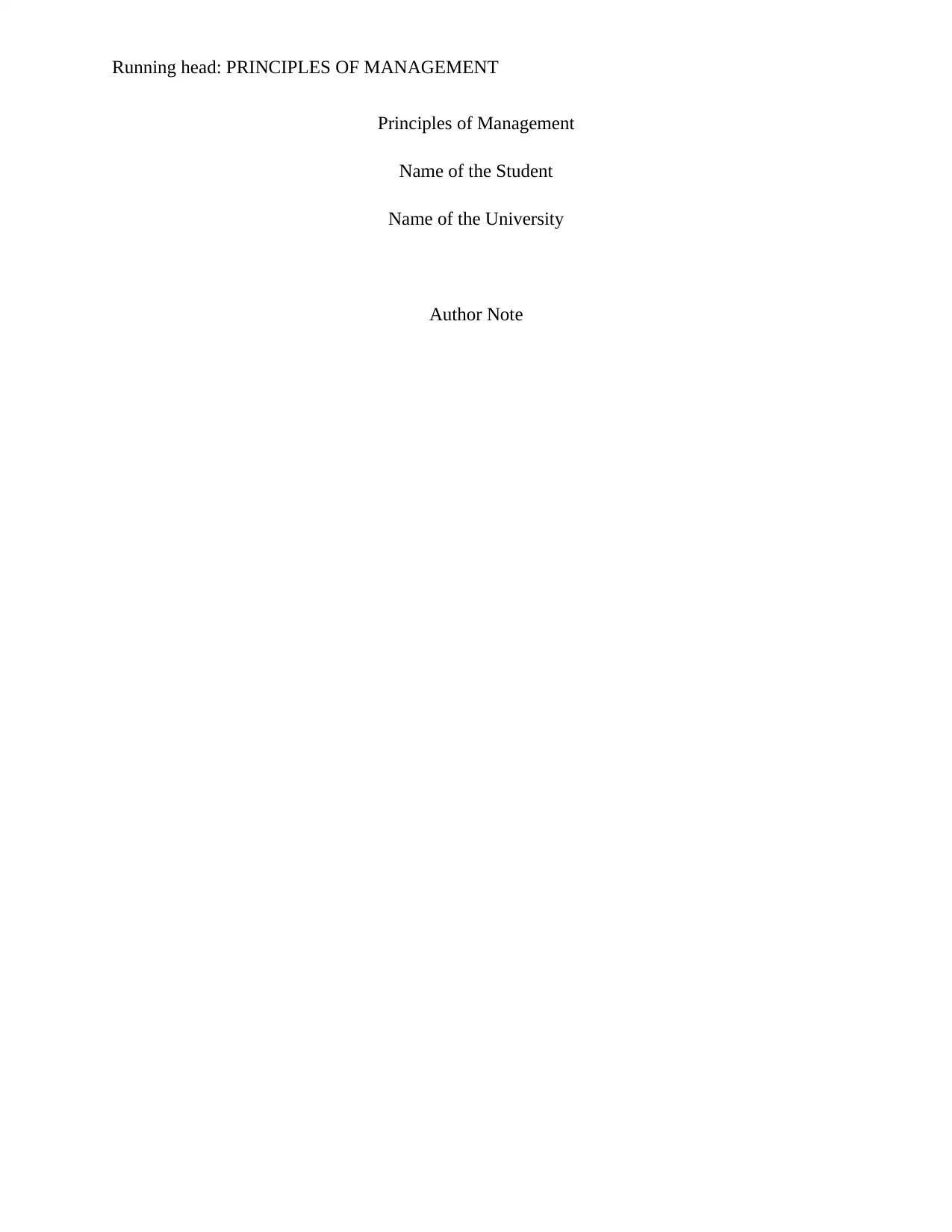
Running head: PRINCIPLES OF MANAGEMENT
Principles of Management
Name of the Student
Name of the University
Author Note
Principles of Management
Name of the Student
Name of the University
Author Note
Paraphrase This Document
Need a fresh take? Get an instant paraphrase of this document with our AI Paraphraser
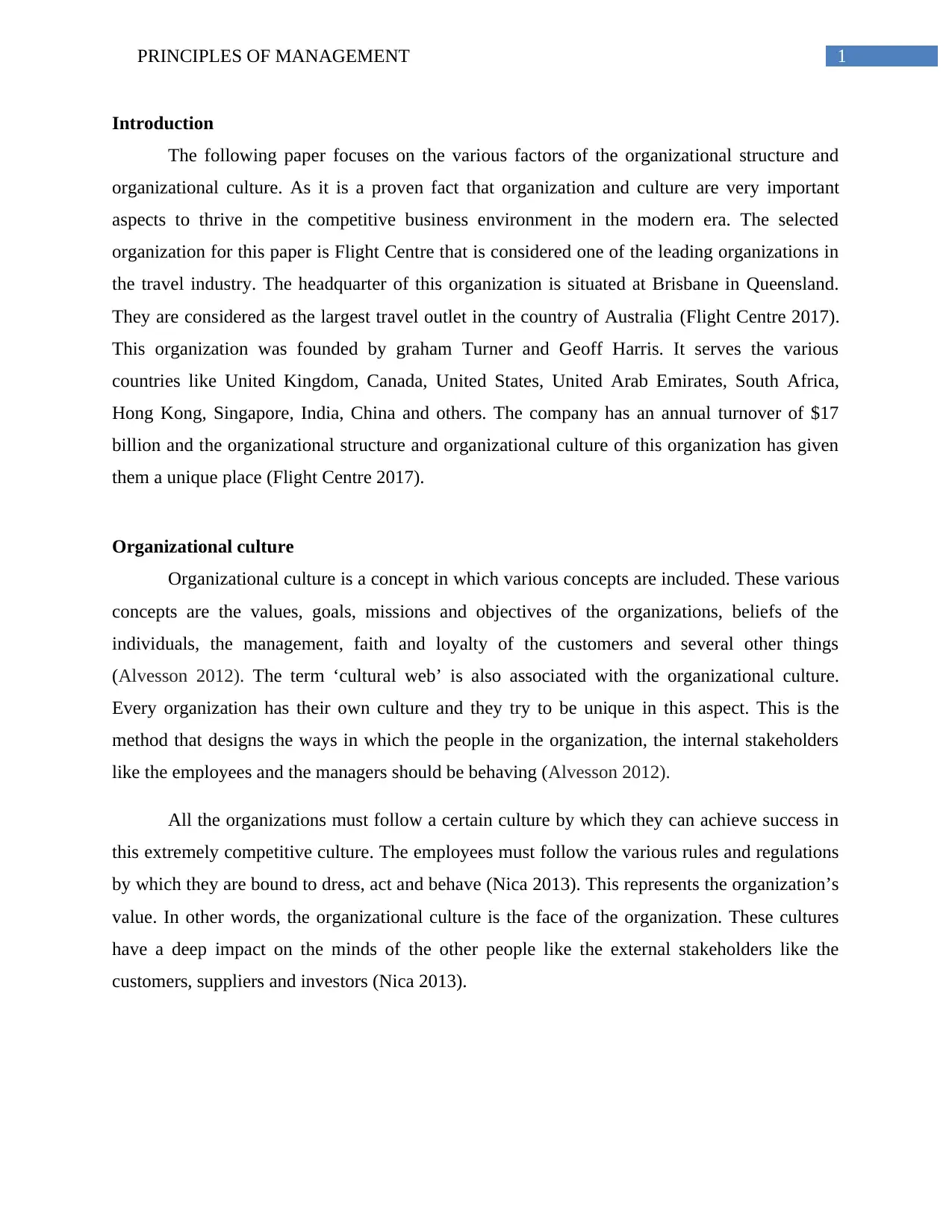
1PRINCIPLES OF MANAGEMENT
Introduction
The following paper focuses on the various factors of the organizational structure and
organizational culture. As it is a proven fact that organization and culture are very important
aspects to thrive in the competitive business environment in the modern era. The selected
organization for this paper is Flight Centre that is considered one of the leading organizations in
the travel industry. The headquarter of this organization is situated at Brisbane in Queensland.
They are considered as the largest travel outlet in the country of Australia (Flight Centre 2017).
This organization was founded by graham Turner and Geoff Harris. It serves the various
countries like United Kingdom, Canada, United States, United Arab Emirates, South Africa,
Hong Kong, Singapore, India, China and others. The company has an annual turnover of $17
billion and the organizational structure and organizational culture of this organization has given
them a unique place (Flight Centre 2017).
Organizational culture
Organizational culture is a concept in which various concepts are included. These various
concepts are the values, goals, missions and objectives of the organizations, beliefs of the
individuals, the management, faith and loyalty of the customers and several other things
(Alvesson 2012). The term ‘cultural web’ is also associated with the organizational culture.
Every organization has their own culture and they try to be unique in this aspect. This is the
method that designs the ways in which the people in the organization, the internal stakeholders
like the employees and the managers should be behaving (Alvesson 2012).
All the organizations must follow a certain culture by which they can achieve success in
this extremely competitive culture. The employees must follow the various rules and regulations
by which they are bound to dress, act and behave (Nica 2013). This represents the organization’s
value. In other words, the organizational culture is the face of the organization. These cultures
have a deep impact on the minds of the other people like the external stakeholders like the
customers, suppliers and investors (Nica 2013).
Introduction
The following paper focuses on the various factors of the organizational structure and
organizational culture. As it is a proven fact that organization and culture are very important
aspects to thrive in the competitive business environment in the modern era. The selected
organization for this paper is Flight Centre that is considered one of the leading organizations in
the travel industry. The headquarter of this organization is situated at Brisbane in Queensland.
They are considered as the largest travel outlet in the country of Australia (Flight Centre 2017).
This organization was founded by graham Turner and Geoff Harris. It serves the various
countries like United Kingdom, Canada, United States, United Arab Emirates, South Africa,
Hong Kong, Singapore, India, China and others. The company has an annual turnover of $17
billion and the organizational structure and organizational culture of this organization has given
them a unique place (Flight Centre 2017).
Organizational culture
Organizational culture is a concept in which various concepts are included. These various
concepts are the values, goals, missions and objectives of the organizations, beliefs of the
individuals, the management, faith and loyalty of the customers and several other things
(Alvesson 2012). The term ‘cultural web’ is also associated with the organizational culture.
Every organization has their own culture and they try to be unique in this aspect. This is the
method that designs the ways in which the people in the organization, the internal stakeholders
like the employees and the managers should be behaving (Alvesson 2012).
All the organizations must follow a certain culture by which they can achieve success in
this extremely competitive culture. The employees must follow the various rules and regulations
by which they are bound to dress, act and behave (Nica 2013). This represents the organization’s
value. In other words, the organizational culture is the face of the organization. These cultures
have a deep impact on the minds of the other people like the external stakeholders like the
customers, suppliers and investors (Nica 2013).
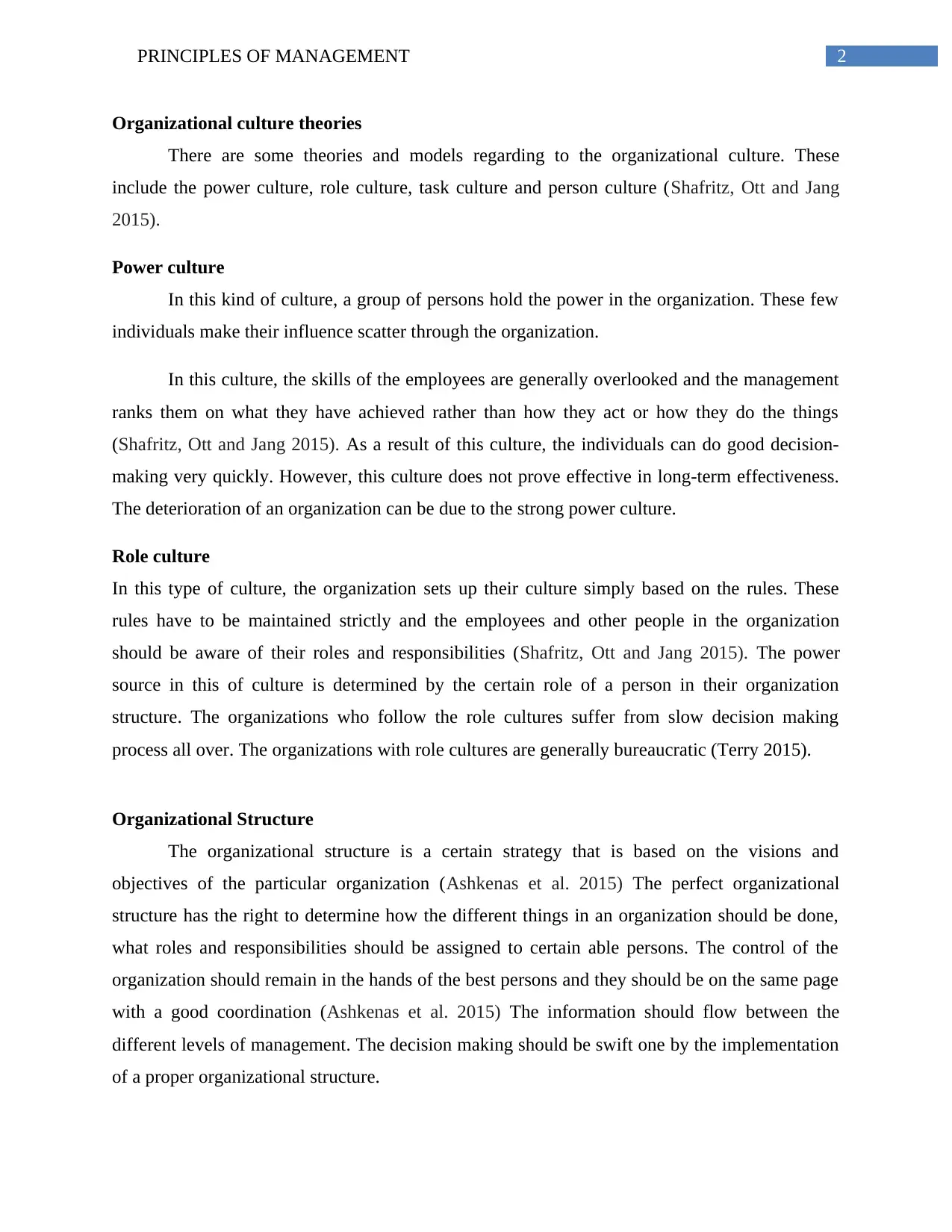
2PRINCIPLES OF MANAGEMENT
Organizational culture theories
There are some theories and models regarding to the organizational culture. These
include the power culture, role culture, task culture and person culture (Shafritz, Ott and Jang
2015).
Power culture
In this kind of culture, a group of persons hold the power in the organization. These few
individuals make their influence scatter through the organization.
In this culture, the skills of the employees are generally overlooked and the management
ranks them on what they have achieved rather than how they act or how they do the things
(Shafritz, Ott and Jang 2015). As a result of this culture, the individuals can do good decision-
making very quickly. However, this culture does not prove effective in long-term effectiveness.
The deterioration of an organization can be due to the strong power culture.
Role culture
In this type of culture, the organization sets up their culture simply based on the rules. These
rules have to be maintained strictly and the employees and other people in the organization
should be aware of their roles and responsibilities (Shafritz, Ott and Jang 2015). The power
source in this of culture is determined by the certain role of a person in their organization
structure. The organizations who follow the role cultures suffer from slow decision making
process all over. The organizations with role cultures are generally bureaucratic (Terry 2015).
Organizational Structure
The organizational structure is a certain strategy that is based on the visions and
objectives of the particular organization (Ashkenas et al. 2015) The perfect organizational
structure has the right to determine how the different things in an organization should be done,
what roles and responsibilities should be assigned to certain able persons. The control of the
organization should remain in the hands of the best persons and they should be on the same page
with a good coordination (Ashkenas et al. 2015) The information should flow between the
different levels of management. The decision making should be swift one by the implementation
of a proper organizational structure.
Organizational culture theories
There are some theories and models regarding to the organizational culture. These
include the power culture, role culture, task culture and person culture (Shafritz, Ott and Jang
2015).
Power culture
In this kind of culture, a group of persons hold the power in the organization. These few
individuals make their influence scatter through the organization.
In this culture, the skills of the employees are generally overlooked and the management
ranks them on what they have achieved rather than how they act or how they do the things
(Shafritz, Ott and Jang 2015). As a result of this culture, the individuals can do good decision-
making very quickly. However, this culture does not prove effective in long-term effectiveness.
The deterioration of an organization can be due to the strong power culture.
Role culture
In this type of culture, the organization sets up their culture simply based on the rules. These
rules have to be maintained strictly and the employees and other people in the organization
should be aware of their roles and responsibilities (Shafritz, Ott and Jang 2015). The power
source in this of culture is determined by the certain role of a person in their organization
structure. The organizations who follow the role cultures suffer from slow decision making
process all over. The organizations with role cultures are generally bureaucratic (Terry 2015).
Organizational Structure
The organizational structure is a certain strategy that is based on the visions and
objectives of the particular organization (Ashkenas et al. 2015) The perfect organizational
structure has the right to determine how the different things in an organization should be done,
what roles and responsibilities should be assigned to certain able persons. The control of the
organization should remain in the hands of the best persons and they should be on the same page
with a good coordination (Ashkenas et al. 2015) The information should flow between the
different levels of management. The decision making should be swift one by the implementation
of a proper organizational structure.
⊘ This is a preview!⊘
Do you want full access?
Subscribe today to unlock all pages.

Trusted by 1+ million students worldwide
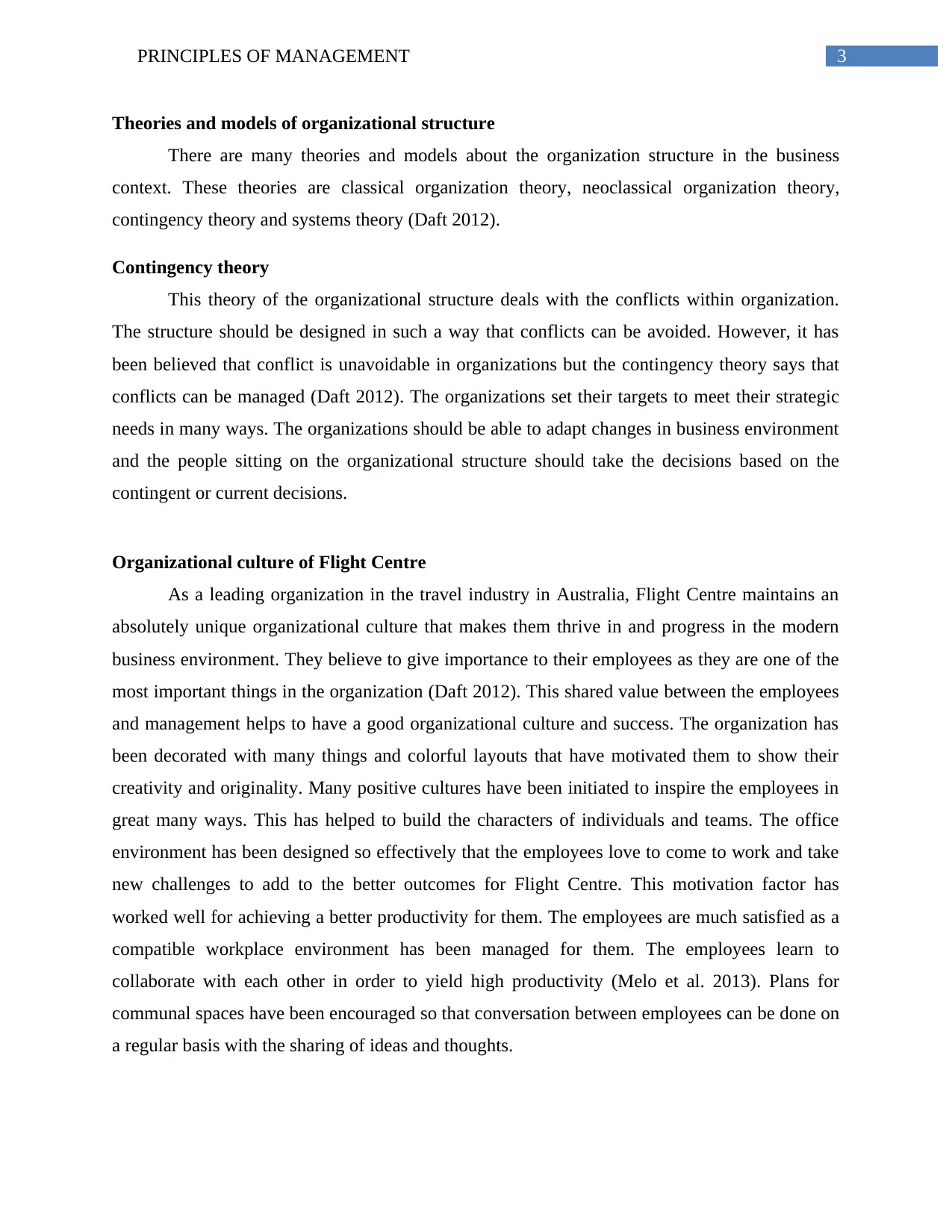
3PRINCIPLES OF MANAGEMENT
Theories and models of organizational structure
There are many theories and models about the organization structure in the business
context. These theories are classical organization theory, neoclassical organization theory,
contingency theory and systems theory (Daft 2012).
Contingency theory
This theory of the organizational structure deals with the conflicts within organization.
The structure should be designed in such a way that conflicts can be avoided. However, it has
been believed that conflict is unavoidable in organizations but the contingency theory says that
conflicts can be managed (Daft 2012). The organizations set their targets to meet their strategic
needs in many ways. The organizations should be able to adapt changes in business environment
and the people sitting on the organizational structure should take the decisions based on the
contingent or current decisions.
Organizational culture of Flight Centre
As a leading organization in the travel industry in Australia, Flight Centre maintains an
absolutely unique organizational culture that makes them thrive in and progress in the modern
business environment. They believe to give importance to their employees as they are one of the
most important things in the organization (Daft 2012). This shared value between the employees
and management helps to have a good organizational culture and success. The organization has
been decorated with many things and colorful layouts that have motivated them to show their
creativity and originality. Many positive cultures have been initiated to inspire the employees in
great many ways. This has helped to build the characters of individuals and teams. The office
environment has been designed so effectively that the employees love to come to work and take
new challenges to add to the better outcomes for Flight Centre. This motivation factor has
worked well for achieving a better productivity for them. The employees are much satisfied as a
compatible workplace environment has been managed for them. The employees learn to
collaborate with each other in order to yield high productivity (Melo et al. 2013). Plans for
communal spaces have been encouraged so that conversation between employees can be done on
a regular basis with the sharing of ideas and thoughts.
Theories and models of organizational structure
There are many theories and models about the organization structure in the business
context. These theories are classical organization theory, neoclassical organization theory,
contingency theory and systems theory (Daft 2012).
Contingency theory
This theory of the organizational structure deals with the conflicts within organization.
The structure should be designed in such a way that conflicts can be avoided. However, it has
been believed that conflict is unavoidable in organizations but the contingency theory says that
conflicts can be managed (Daft 2012). The organizations set their targets to meet their strategic
needs in many ways. The organizations should be able to adapt changes in business environment
and the people sitting on the organizational structure should take the decisions based on the
contingent or current decisions.
Organizational culture of Flight Centre
As a leading organization in the travel industry in Australia, Flight Centre maintains an
absolutely unique organizational culture that makes them thrive in and progress in the modern
business environment. They believe to give importance to their employees as they are one of the
most important things in the organization (Daft 2012). This shared value between the employees
and management helps to have a good organizational culture and success. The organization has
been decorated with many things and colorful layouts that have motivated them to show their
creativity and originality. Many positive cultures have been initiated to inspire the employees in
great many ways. This has helped to build the characters of individuals and teams. The office
environment has been designed so effectively that the employees love to come to work and take
new challenges to add to the better outcomes for Flight Centre. This motivation factor has
worked well for achieving a better productivity for them. The employees are much satisfied as a
compatible workplace environment has been managed for them. The employees learn to
collaborate with each other in order to yield high productivity (Melo et al. 2013). Plans for
communal spaces have been encouraged so that conversation between employees can be done on
a regular basis with the sharing of ideas and thoughts.
Paraphrase This Document
Need a fresh take? Get an instant paraphrase of this document with our AI Paraphraser
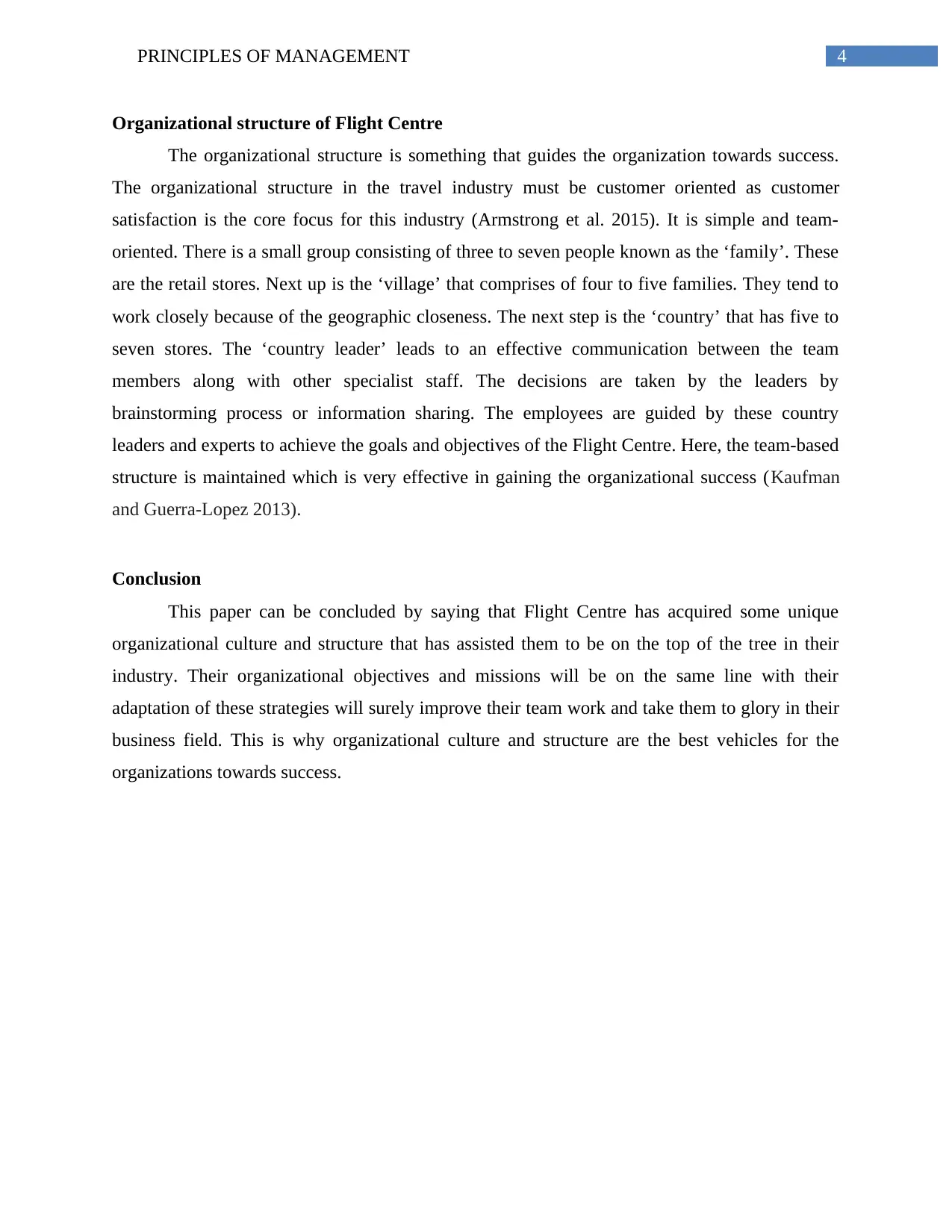
4PRINCIPLES OF MANAGEMENT
Organizational structure of Flight Centre
The organizational structure is something that guides the organization towards success.
The organizational structure in the travel industry must be customer oriented as customer
satisfaction is the core focus for this industry (Armstrong et al. 2015). It is simple and team-
oriented. There is a small group consisting of three to seven people known as the ‘family’. These
are the retail stores. Next up is the ‘village’ that comprises of four to five families. They tend to
work closely because of the geographic closeness. The next step is the ‘country’ that has five to
seven stores. The ‘country leader’ leads to an effective communication between the team
members along with other specialist staff. The decisions are taken by the leaders by
brainstorming process or information sharing. The employees are guided by these country
leaders and experts to achieve the goals and objectives of the Flight Centre. Here, the team-based
structure is maintained which is very effective in gaining the organizational success (Kaufman
and Guerra-Lopez 2013).
Conclusion
This paper can be concluded by saying that Flight Centre has acquired some unique
organizational culture and structure that has assisted them to be on the top of the tree in their
industry. Their organizational objectives and missions will be on the same line with their
adaptation of these strategies will surely improve their team work and take them to glory in their
business field. This is why organizational culture and structure are the best vehicles for the
organizations towards success.
Organizational structure of Flight Centre
The organizational structure is something that guides the organization towards success.
The organizational structure in the travel industry must be customer oriented as customer
satisfaction is the core focus for this industry (Armstrong et al. 2015). It is simple and team-
oriented. There is a small group consisting of three to seven people known as the ‘family’. These
are the retail stores. Next up is the ‘village’ that comprises of four to five families. They tend to
work closely because of the geographic closeness. The next step is the ‘country’ that has five to
seven stores. The ‘country leader’ leads to an effective communication between the team
members along with other specialist staff. The decisions are taken by the leaders by
brainstorming process or information sharing. The employees are guided by these country
leaders and experts to achieve the goals and objectives of the Flight Centre. Here, the team-based
structure is maintained which is very effective in gaining the organizational success (Kaufman
and Guerra-Lopez 2013).
Conclusion
This paper can be concluded by saying that Flight Centre has acquired some unique
organizational culture and structure that has assisted them to be on the top of the tree in their
industry. Their organizational objectives and missions will be on the same line with their
adaptation of these strategies will surely improve their team work and take them to glory in their
business field. This is why organizational culture and structure are the best vehicles for the
organizations towards success.
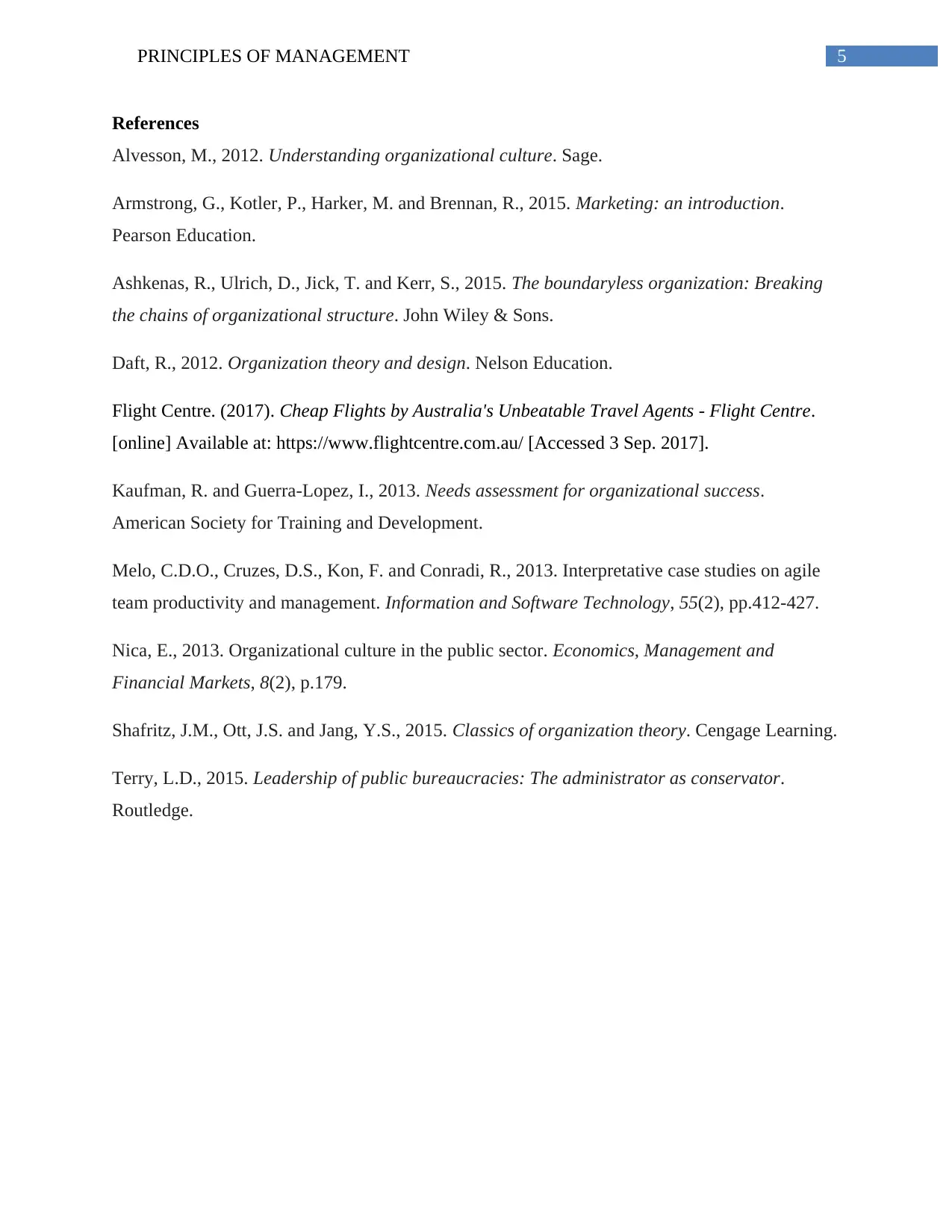
5PRINCIPLES OF MANAGEMENT
References
Alvesson, M., 2012. Understanding organizational culture. Sage.
Armstrong, G., Kotler, P., Harker, M. and Brennan, R., 2015. Marketing: an introduction.
Pearson Education.
Ashkenas, R., Ulrich, D., Jick, T. and Kerr, S., 2015. The boundaryless organization: Breaking
the chains of organizational structure. John Wiley & Sons.
Daft, R., 2012. Organization theory and design. Nelson Education.
Flight Centre. (2017). Cheap Flights by Australia's Unbeatable Travel Agents - Flight Centre.
[online] Available at: https://www.flightcentre.com.au/ [Accessed 3 Sep. 2017].
Kaufman, R. and Guerra-Lopez, I., 2013. Needs assessment for organizational success.
American Society for Training and Development.
Melo, C.D.O., Cruzes, D.S., Kon, F. and Conradi, R., 2013. Interpretative case studies on agile
team productivity and management. Information and Software Technology, 55(2), pp.412-427.
Nica, E., 2013. Organizational culture in the public sector. Economics, Management and
Financial Markets, 8(2), p.179.
Shafritz, J.M., Ott, J.S. and Jang, Y.S., 2015. Classics of organization theory. Cengage Learning.
Terry, L.D., 2015. Leadership of public bureaucracies: The administrator as conservator.
Routledge.
References
Alvesson, M., 2012. Understanding organizational culture. Sage.
Armstrong, G., Kotler, P., Harker, M. and Brennan, R., 2015. Marketing: an introduction.
Pearson Education.
Ashkenas, R., Ulrich, D., Jick, T. and Kerr, S., 2015. The boundaryless organization: Breaking
the chains of organizational structure. John Wiley & Sons.
Daft, R., 2012. Organization theory and design. Nelson Education.
Flight Centre. (2017). Cheap Flights by Australia's Unbeatable Travel Agents - Flight Centre.
[online] Available at: https://www.flightcentre.com.au/ [Accessed 3 Sep. 2017].
Kaufman, R. and Guerra-Lopez, I., 2013. Needs assessment for organizational success.
American Society for Training and Development.
Melo, C.D.O., Cruzes, D.S., Kon, F. and Conradi, R., 2013. Interpretative case studies on agile
team productivity and management. Information and Software Technology, 55(2), pp.412-427.
Nica, E., 2013. Organizational culture in the public sector. Economics, Management and
Financial Markets, 8(2), p.179.
Shafritz, J.M., Ott, J.S. and Jang, Y.S., 2015. Classics of organization theory. Cengage Learning.
Terry, L.D., 2015. Leadership of public bureaucracies: The administrator as conservator.
Routledge.
⊘ This is a preview!⊘
Do you want full access?
Subscribe today to unlock all pages.

Trusted by 1+ million students worldwide
1 out of 6
Related Documents
Your All-in-One AI-Powered Toolkit for Academic Success.
+13062052269
info@desklib.com
Available 24*7 on WhatsApp / Email
![[object Object]](/_next/static/media/star-bottom.7253800d.svg)
Unlock your academic potential
Copyright © 2020–2025 A2Z Services. All Rights Reserved. Developed and managed by ZUCOL.





